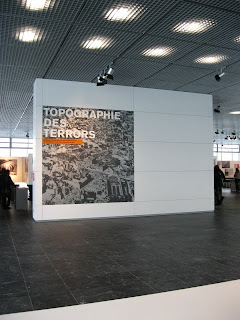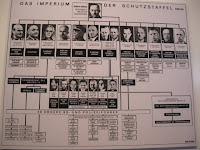 The Topography of Terror museum is a great big, self-conscious cube of a building, sitting a long ways back from the road on a vast lawn (or snow field, in winter), bound on the north side by remains of the Berlin Wall. The museum is built upon what’s referred to as the “site of the perpetrators”—that is, the topographical location from which the Nazis planned and carried out most of their crimes. Entrance is completely free. And that’s great, but really the only way it could be, right? Germany seems to know where profit is socially acceptable and where it isn’t, and it is definitely to the city’s credit that this museum is open and available to anyone with the desire to see what’s inside.
The Topography of Terror museum is a great big, self-conscious cube of a building, sitting a long ways back from the road on a vast lawn (or snow field, in winter), bound on the north side by remains of the Berlin Wall. The museum is built upon what’s referred to as the “site of the perpetrators”—that is, the topographical location from which the Nazis planned and carried out most of their crimes. Entrance is completely free. And that’s great, but really the only way it could be, right? Germany seems to know where profit is socially acceptable and where it isn’t, and it is definitely to the city’s credit that this museum is open and available to anyone with the desire to see what’s inside.This mandate, that something of such importance be made “free to be seen,” is the first thing I want to ramble about, because it seems very central to the greater design of Berlin and its on-going critical conversation regarding its history. For example, recent construction on the official German government building, the Reichstag, includes a dome on top made entirely of glass windowpanes, maximizing its literal transparency; anyone can see into the building and, theoretically, I guess, know what government officials are doing. In this way, the building stands to embody the German government’s new ideals after Reunification and the fall of the Berlin Wall—to have a government that does not obfuscate its proceedings, etc. The same transparency of architecture can be seen in the Marie-Elisabeth-Lüders-Haus (which contains the Parliament’s library, archive, classified information, and press documents).
 So back to the Topography of Terror Museum—my boyfriend, Matt, made a really interesting observation about its architecture—that this building exists as a foil to the transparent contemporary government buildings, as the TT museum is built with a slatted facade over its own large windowpanes. While entrance to the museum is free and allows equal and total access to its resources (including a digital archive of NS documents, records, correspondence, etc.) the building itself conceals the objects and activities going on inside, thus serving as a reminder of how terror—a dictatorship, total loss of civil liberties, genocide—arose.
So back to the Topography of Terror Museum—my boyfriend, Matt, made a really interesting observation about its architecture—that this building exists as a foil to the transparent contemporary government buildings, as the TT museum is built with a slatted facade over its own large windowpanes. While entrance to the museum is free and allows equal and total access to its resources (including a digital archive of NS documents, records, correspondence, etc.) the building itself conceals the objects and activities going on inside, thus serving as a reminder of how terror—a dictatorship, total loss of civil liberties, genocide—arose.Inside the museum, I was surprised to find the display made up entirely of text and image—all original objects that belonged to or bear association with the National Socialist Party are kept elsewhere. It is an unusual sort of museum in this respect, and I admit that I was a little disappointed at first. Who doesn’t want to see the material evidence of massive world history? But it is easy to appreciate what the museum does provide, which is an historical documentation of the NS dictatorship by way of concise descriptions, quotation, and photography, with a particular emphasis on the perpetrators of terror.
Given this focus of the exhibit upon the war criminals, the mechanisms of their administration
 and seizure of power, I learned a lot that I didn’t already know about the National Socialist Party. The plain facts of Nazi leadership are completely shocking and horrifying, and yet throughout the museum I was especially affected by the photographs—not just of concentration camps or the NS rallies (there were those, too), but very revealing and personal photographs of, for example, a Nazi Christmas party; the faces of dissidents; the public shearing of women accused of “intimate contacts” with prisoners of war; guards from Auschwitz at the SS retreat in Sola-Hütte (“an idyllic mountain landscape”); former members of the SS guard, hiding their faces from the cameras at the second Treblinka trial.
and seizure of power, I learned a lot that I didn’t already know about the National Socialist Party. The plain facts of Nazi leadership are completely shocking and horrifying, and yet throughout the museum I was especially affected by the photographs—not just of concentration camps or the NS rallies (there were those, too), but very revealing and personal photographs of, for example, a Nazi Christmas party; the faces of dissidents; the public shearing of women accused of “intimate contacts” with prisoners of war; guards from Auschwitz at the SS retreat in Sola-Hütte (“an idyllic mountain landscape”); former members of the SS guard, hiding their faces from the cameras at the second Treblinka trial.The range of the photographs is impressive, and what they depict extremely emotional; in my opinion, it is very important to see. The Topography of Terror museum makes for a heavy afternoon but, should emotional and psychological weariness set in, there is an amazing and enormous book available (in either English or German for 15€) that contains the entire display—the text in 12 point font and the photographs in black and white.
No comments:
Post a Comment